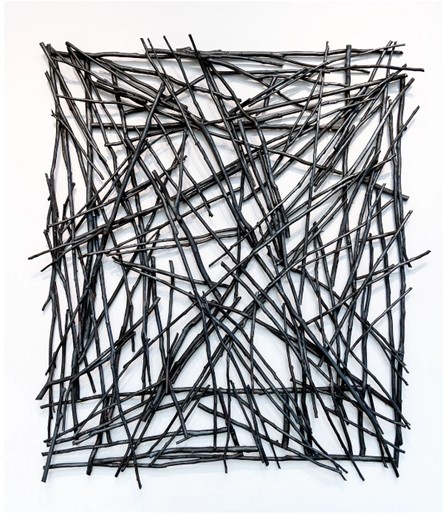
Charlotte Jackson Fine Art is proud to present an exhibition of new work, Rock, Paper, Scissors, by Charles Arnoldi. The exhibition will run from May 26 through June 24. An Opening Reception and book signing will be held on Friday, May 26 from 5-7 p.m. The gallery is located in the Railyard Arts District at 554 South Guadalupe Street.
Don’t hold your arms stiff and tight against your sides. As you walk through Charles Arnoldi’s exhibition of new work, Rock, Paper, Scissors, let yourself move freely. Let yourself feel the movement. You are a three-dimensional body in space. Yes, your eyes will soak up the lines, the intricate patterning overlap of Arnoldi’s latest explorations of Stick Paintings. You will see the rich patinas of copper and iron paint on examples of new Chainsaw pieces. And you will search for the ways that lines, cracks, texture and shadows interact on his puzzle-like stacked sculptural forms. But Arnoldi’s medium is more than visual, more than paint or metal, than sticks, wood, or foam. Arnoldi works with space. And more properly – with movement through space.
Arnoldi has never been one to let himself be pigeonholed or branded. His art is constantly shifting and evolving. In his fifth decade working as an artist, Arnoldi has used nearly any medium you could think of: metals, foam, plaster, wood, paint and beyond. He has drawn inspiration from the charcoal-line-like branches of forest fire burned trees, from the forms and formalities of architecture, from the vast and mysterious ruins of Machu Pichu, from fellow artists like Rauschenberg, Stella, and Johns, and even from the humble potato. Life and experience permeate and constantly shift his vision and his work. It is the interchange itself that seems to interest him: making an object, working on it until it has a life of its own, and then entering into a dialogue with it. Pushing that dialogue as far as it can go. Once Arnoldi gets a particular idea, he is prolific – exploring all the ways that he can approach that particular question or perspective. While artistic superstardom might have come sooner had he stuck to one primary visual vocabulary, for Arnoldi, it is the creativity, the energy of the exploration that drives him. As he says, “You have to have as much doubt as confidence in what you’re doing.”
However, with over five decades of work, what can at first seem to be very disparate visual expressions begin to collate. There are through lines to Arnoldi’s work, questions that seem to pull him back again and again. One of these elements is the exploration of space which is so palpably present in the work of Rock, Paper, Scissors.
Here we have a whole new re-engagement with the Stick Paintings – taking the idea of the line out into space with complex and elegant constructions of acrylic-painted sticks. The juxtaposition of these 3D lines is all the more apparent as they play off of the 2D shadows they cast on the gallery wall. The two large plaster and foam panel pieces take Arnoldi’s negative-space Chainsaw paintings and add new dimensions – not least that these are carved from a special kind of foam rather than from wood blocks or wood panels. Here those 3D lines are scratched out volumes of space rather than of physical matter. The Stackable sculptures combine elements of several of Arnoldi’s explorations: architectural, puzzle-pieced like the ever-evolving Machu Pichu series, aggregate panels/pieces that can inhabit space in multiple ways depending on arrangement.
Some have said that there is a sixth sense. Beyond sight, hearing, taste, touch, and smell, some scientists propose proprioception: the sense of self-movement, force, and body position. Knowing oneself as a three-dimensional body in space.
An interesting thing happens as you walk through the gallery among these pieces, you may begin to feel yourself inhabiting space, as these pieces do. The long, woven, sweep and return of the sticks becomes movement that you can feel as gesture. The deep scoring of the chain-sawed panels becomes an inward folding movement, the body curving itself around a central spine. The stacked sculptures, balanced so precariously – the movements of a complicated dance slowed down infinitely to near stillness.
Which brings us to the genius of Arnoldi’s work – the ability to translate his own quest, his ongoing dialogue with objects of art, to us, as viewers. We must engage these pieces in conversation, meet them on equal ground, give and ask: embodied form to embodied form.
-Michaela Kahn, Ph.D.
